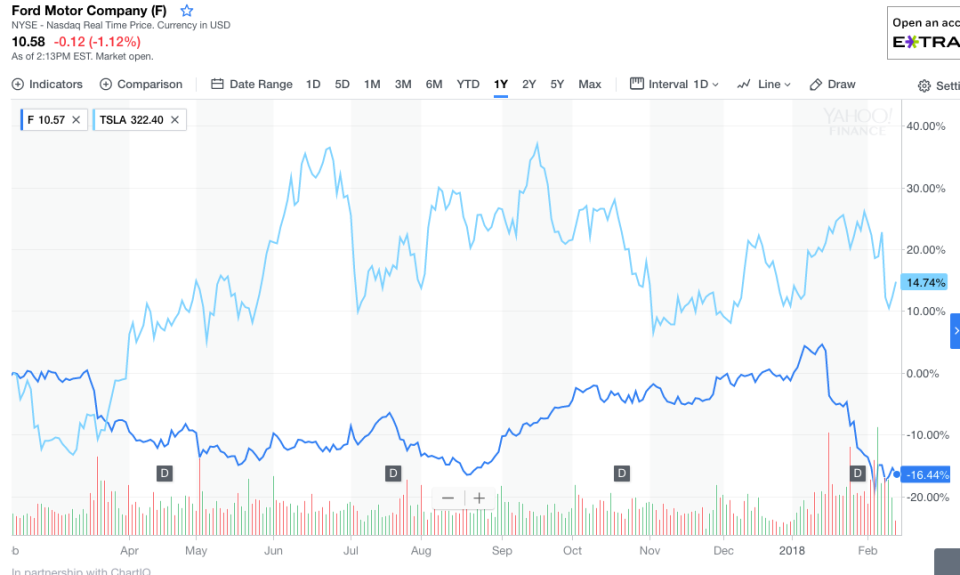Why Wall Street punishes Ford
It builds some iconic products, and even turns a profit doing so. Yet Ford (F) is one of the most unloved stocks among big companies, lagging at least one competitor that has never even made money.
Ford’s stock has fallen 15% in the last year, while the S&P 500 index is up 14%. Tesla’s (TSLA) market value is 25% greater than Ford’s, even though Tesla has never turned an annual profit, and Ford sells more cars in a day than Tesla sells in a quarter. Ford badly lags its traditional rivals as well, with General Motors (GM), Toyota (TM) and Fiat Chrysler (FCAU) all handily outperforming Ford shares during the last year.
So what’s the problem? “Wall Street wants improved results in our automotive business. We understand that,” Joe Hinrichs, Ford executive vice president, tells Yahoo Finance in the video above. “They also want clarity on where the future’s going, and they want to be able to model where the profits are coming from in the future. Most of us can’t explain it yet.”
The auto industry’s future is uncertain because electrification and self-driving cars threaten to shake things up. In 20 years, drivers might share cars instead of owning them outright. Owners might charge up at home instead of visiting a filling station. Steering wheels and gas pedals might disappear, as cars pilot themselves and controls become entirely electronic. Instead of Uber drivers, there might be robocars.
Or, car ownership might look more or less like it does now, just with fancier vehicles.
Wall Street is betting on disruptive change, which is why investors love Tesla—they think it’s got a key edge on electrification, a technology of the future. But Ford, GM and most other big automakers are investing in the same technology, and it’s possible something other than battery-powered cars could dominate the roads in a decade or two or three.

Ford fired CEO Mark Fields last year, amid dissatisfaction that the storied automaker wasn’t changing fast enough. Jim Hackett, a former furniture executive replaced him. So far, Wall Street seems unimpressed, with no obvious bump in the stock under Hackett’s 9-month tenure.
Ford is in the middle of a streamlining plan that includes improving manufacturing efficiency, paying down debt and partnering with other companies on cutting-edge technology, to lower costs and speed development. The street is lukewarm; of 22 analysts surveyed by S&P Capital IQ, the average rating on the stock is a hold.
Lincoln, a division of Ford, also needs to revitalize the Lincoln luxury brand, which has a couple of well-known nameplates—the Continental sedan and the Navigator SUV—along with a few other vehicles nobody knows by name, such as the MKZ and MKX. The bland alphabet-soup names will soon disappear, replaced by names meant to be more evocative.
More crossovers and SUVs are coming to both Ford and Lincoln, to fill gaps. The new Ranger pickup and the forthcoming Bronco SUV will be Jeeplike vehicles aimed at rambunctious off-roaders.
Meanwhile, Ford is leaning on stalwarts like F-150 pickup and SUVs like the Navigator and Expedition to keep revenue rolling in, while it undergoes what Hinrichs calls a “fitness redesign.” “We’re taking cost out and getting more competitively fit for the future,” he says. Wall Street awaits the proof.


